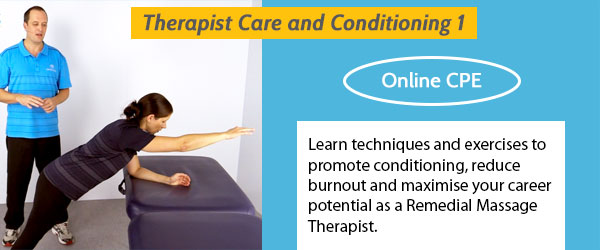If you were asked what your most effective technique is, how would answer? Would you explain that trigger point techniques are the most effective, they are the best for reducing pain right? What about myofascial release, it is backed up by all the research into fascia isn’t it? How about muscle energy techniques, they are an active technique so perhaps they could be even more effective than passive massage techniques? Or would you answer that there is no one technique that is best and it is matter of selecting the right technique for the individual? Would you consider for a moment that your best technique might not have anything to do with massage at all?
For many years now remedial massage courses have been taught right across Australia and the ‘three pillars’ of these courses have been:
- Trigger point therapy
- Myofascial release,
- Stretching and variations of deep tissue massage.
These foundation techniques have always been described as the key to getting great results. How would feel if you found out that reduction of pain, tightness and improved function is not a result of de-activating a trigger point, lengthening fascia or aligning some structure? Would you fight the idea, recalling all of you training, your lecturers telling you that rebalancing the body is the solution to pain or dysfunction?
The “Giant Leap”
As massage therapists we need to get over the concept that we are making changes to client’s tissues. Any changes that occur to a client’s body are as a result of their nervous system (their brain) responding to our touch.
I’m not writing this article to challenge the techniques you have been taught, rather to encourage you to take the great leap with me and think outside the box! As a therapist you know there are many “tools” you can use and a client will obviously be expecting hands-on treatment. But, there is another tool that is under-utilised and it is simply the powerful tool you can use…
The single most effective tool you have as a massage therapist is your client. The most critical “techniques” a massage therapist has are communication, listening and careful conscious touch. The single most effective “technique” is to enabling your client to be involved and focused during their massage treatment and allow their body to make changes.
For years I always thought that it was my pressure that stretched, lengthened and released a client’s tissues, with the exception of moving lymph through the body research is telling us that it is basically impossible to have any lasting effect on the body’s tissues, unless we work so hard we bruise somebody!
Join the Bright Health Training newsletter
This is taken from the Journal of the American Osteopathic Association;
Our calculations reveal that the dense tissues of plantar fascia and fascia lata require very large forces—far outside the human physiologic range—to produce even 1% compression and 1% shear. However, softer tissues, such as superficial nasal fascia, deform under strong forces that may be at the upper bounds of physiologic limits. Although some manual therapists anecdotally report palpable tissue release in dense fasciae, such observations are probably not caused by deformations produced by compression or shear. Rather, these palpable effects are more likely the result of reflexive changes in the tissue—or changes in twisting or extension forces in the tissue.
As massage therapists we have to let go of the idea that we are fixing people. People fix themselves, we are just creating the environment for them to do so.
Ye Olde Placebo Effect
We’ve all heard of the placebo effect, but do you know how effective it can actually be? In one review of the placebo effect on pain, the placebo effect alone showed between a 25% – 32% reduction of pain on the visual analogue scale. In real terms, this is a client changing from a pain score of 10 (out of 10) to 6 or 7. Just from belief of an effective treatment! Add on top of this real physiological pain reduction from treatment and you are talking powerful pain relief.
 In one acupuncture study, sham acupuncture and real acupuncture treatments were compared for pain management. The research showed no difference between sham and real treatments for pain reduction. What did show a significant difference in pain reduction was whether a patient believed they were getting a real treatment or a sham treatment. In other words, the patients’ beliefs, or perception, had more impact on their pain than the type of treatment!
In one acupuncture study, sham acupuncture and real acupuncture treatments were compared for pain management. The research showed no difference between sham and real treatments for pain reduction. What did show a significant difference in pain reduction was whether a patient believed they were getting a real treatment or a sham treatment. In other words, the patients’ beliefs, or perception, had more impact on their pain than the type of treatment!
It is worth noting that quite a bit of research has gone into acupuncture treating pain. In a British Medical Journal review of research into acupuncture for pain treatment, that looked at research from the last decade, no significant effect on pain from acupuncture could be found. At best there was a slight effect that would not make a difference clinically.
One important caveat should be mentioned here, acupuncture and dry needling have been shown to effective in pain reduction for lower back pain when used in combination with other therapies. Which leads to the question, is it actually what is being done that has the most effect on pain or the context that it is being done within?
What About Massage Therapy for Pain?
Well the good news is that massage therapy is currently looking pretty good in terms of the research! The often quoted cochrane review of massage therapy and back pain states that massage might be effective with sub-acute and chronic lower back pain. “Might be” doesn’t sound very positive, but to get a statement like that from the Cochrane review does not come easily. It should be noted that massage outperformed joint mobilisation, relaxation, physical therapy, self care education and acupuncture, in the Cochrane review. Not bad for the massage therapist.
So Why is Massage Effective?
The simple answer is that we don’t know. Many of the explanations that we have been given about what massage does have been shown to be incorrect. But we have some indications that massage is effective for pain, so the logical conclusion is that massage works via a method that we do not yet understand.
That being said, we do have some indications how to improve the effectiveness of massage therapy and you might be surprised at how simple it is.
5 Key Tips For Effective Remedial Massage
Building from the “giant leap”, here are my top 5 essential components of an effective massage treatment. Follow these and I’m confident you’ll see improved results and increased client satisfaction.
1. Listen to the Client
As mentioned previously, the effectiveness of a treatment is largely determined by a client’s perception of the effectiveness of the massage treatment. If you can find out what the client views as an effective treatment and design your treatment plan around the information the client gives you, this will greatly improve your chances of a positive outcome. In other words, if the client thinks they are getting a great treatment, then they are more likely to get great results.
2. Be Holistic
Remember when massage and natural therapies was all about being holistic? They were right. We now know that pain and function is linked to more than just tight muscles or pelvic alignment. The Biopsychosocial perspective recognises that an individual’s perception and experience of pain will relate to what is happening on a biological, psychological and social level. As a massage therapist it is not your job to counsel someone, but it is relevant and indeed beneficial to educate clients that mental stress and social situations will have a significant impact on a client’s physical state.
One of the great benefits of massage treatment is that someone has the ability to relax and reflect on their life whilst in a professional, supportive environment. This can allow someone the time and space to come up with solutions to problems that might be causing stress or aggravating their back pain. Don’t underestimate how powerful this is for a client, their life and their experience of pain.
3. Let the Client Explore Their Dysfunction
If you think that smashing dysfunctional tissue is the way to results then think again! Physiologically, massage has very little direct effect, time and time again this has been demonstrated with research. The changes that occur in the client are a result of internal physiological changes on a neurological level, it can be reflexive or it can occur at a higher level in the brain but it is not the therapist that makes the changes, it is the client. The value of a massage is that you can provide feedback to a client via a massage as to the current state of their tissues. If they are tight, the nervous system can relax, if given the chance.
So we can use massage to addresses dysfunctional tissues, but give the client a chance to feel what is going on, don’t just blind them with pain.
4. Assess Function
It is very easy to get focused on pain during massage treatments. Pain is a very complex physiological process that occurs largely in the brain, not in the tissues we treat. Function needs to be differentiated from pain, focus more on how someone moves, rather than how they feel. If your client can move normally after a treatment it is very likely that if the treatment didn’t relieve their pain, any remaining pain will diminish soon after the treatment.
5. You Can Only Restore or Reset
Gray Cook has been credited with coining the term “resetting”, which is a valid term for massage. Resetting simply means that through treatment you restore a client’s function back to normal. It is literally impossible for a massage to improve a client’s level of function. Massage as much as you like, they will not get stronger, faster or more flexible. At best you can help someone to restore or “reset” their body back the their normal level of function. The concept that you can stretch fascia, or lengthen tissue is ridiculous, all you can do in a massage treatment is return the body back to its normal state.
Summary
So the “giant leap” I am suggesting we need to make is not that giant after all. It does not really mean we need to change much about we are doing, we just need to reconsider what is really happening when we touch a client. A massage therapist can have very little impact on a client’s tissue, but they can have a very powerful effect on the client as a person and on their brain.
I encourage you to explore about our understanding of neuroscience, pain and the physiology of massage. Wherever possible begin exploring scientific research relating to massage, one great place to start is the AMTs research round up.
At first it can be a bit of a shock, but I promise there is great truth shining through that initial shock. At that truth looks very promising for massage therapy.



Comments 3
The placebo effect you mention in your article is such an interesting one. Some people bag the placebo effect, but it is present in all forms of treatment. My view is that if you experience a 30% improvement in your symptoms who really cares what lead to it? Nice job with your article.
The added benefit of course is that massage is one of the few forms of health treatment that people really look forward to! Got to love massage!
Author
Nice one Bruce, I tend to agree, but I think we owe it to our clients or patients that we are as honest as we can be. All the best!